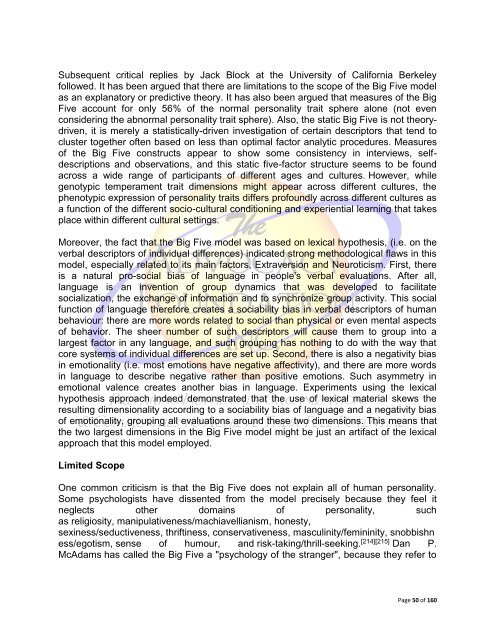The Gift of Introversion
The Gift of Introversion
The Gift of Introversion
You also want an ePaper? Increase the reach of your titles
YUMPU automatically turns print PDFs into web optimized ePapers that Google loves.
Subsequent critical replies by Jack Block at the University <strong>of</strong> California Berkeley<br />
followed. It has been argued that there are limitations to the scope <strong>of</strong> the Big Five model<br />
as an explanatory or predictive theory. It has also been argued that measures <strong>of</strong> the Big<br />
Five account for only 56% <strong>of</strong> the normal personality trait sphere alone (not even<br />
considering the abnormal personality trait sphere). Also, the static Big Five is not theorydriven,<br />
it is merely a statistically-driven investigation <strong>of</strong> certain descriptors that tend to<br />
cluster together <strong>of</strong>ten based on less than optimal factor analytic procedures. Measures<br />
<strong>of</strong> the Big Five constructs appear to show some consistency in interviews, selfdescriptions<br />
and observations, and this static five-factor structure seems to be found<br />
across a wide range <strong>of</strong> participants <strong>of</strong> different ages and cultures. However, while<br />
genotypic temperament trait dimensions might appear across different cultures, the<br />
phenotypic expression <strong>of</strong> personality traits differs pr<strong>of</strong>oundly across different cultures as<br />
a function <strong>of</strong> the different socio-cultural conditioning and experiential learning that takes<br />
place within different cultural settings.<br />
Moreover, the fact that the Big Five model was based on lexical hypothesis, (i.e. on the<br />
verbal descriptors <strong>of</strong> individual differences) indicated strong methodological flaws in this<br />
model, especially related to its main factors, Extraversion and Neuroticism. First, there<br />
is a natural pro-social bias <strong>of</strong> language in people's verbal evaluations. After all,<br />
language is an invention <strong>of</strong> group dynamics that was developed to facilitate<br />
socialization, the exchange <strong>of</strong> information and to synchronize group activity. This social<br />
function <strong>of</strong> language therefore creates a sociability bias in verbal descriptors <strong>of</strong> human<br />
behaviour: there are more words related to social than physical or even mental aspects<br />
<strong>of</strong> behavior. <strong>The</strong> sheer number <strong>of</strong> such descriptors will cause them to group into a<br />
largest factor in any language, and such grouping has nothing to do with the way that<br />
core systems <strong>of</strong> individual differences are set up. Second, there is also a negativity bias<br />
in emotionality (i.e. most emotions have negative affectivity), and there are more words<br />
in language to describe negative rather than positive emotions. Such asymmetry in<br />
emotional valence creates another bias in language. Experiments using the lexical<br />
hypothesis approach indeed demonstrated that the use <strong>of</strong> lexical material skews the<br />
resulting dimensionality according to a sociability bias <strong>of</strong> language and a negativity bias<br />
<strong>of</strong> emotionality, grouping all evaluations around these two dimensions. This means that<br />
the two largest dimensions in the Big Five model might be just an artifact <strong>of</strong> the lexical<br />
approach that this model employed.<br />
Limited Scope<br />
One common criticism is that the Big Five does not explain all <strong>of</strong> human personality.<br />
Some psychologists have dissented from the model precisely because they feel it<br />
neglects other domains <strong>of</strong> personality, such<br />
as religiosity, manipulativeness/machiavellianism, honesty,<br />
sexiness/seductiveness, thriftiness, conservativeness, masculinity/femininity, snobbishn<br />
ess/egotism, sense <strong>of</strong> humour, and risk-taking/thrill-seeking. [214][215] Dan P.<br />
McAdams has called the Big Five a "psychology <strong>of</strong> the stranger", because they refer to<br />
Page 50 <strong>of</strong> 160

















